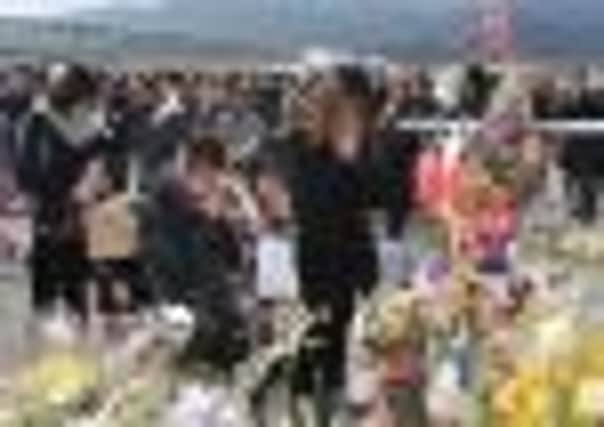Japan unites in remembrance on anniversary of tsunami


In the devastated north-eastern coastal town of Rikuzentakata, a siren sounded at 2:46 – the exact time the magnitude-9.0 quake struck on March 11, 2011 – and a Buddhist priest rang a huge bell at a damaged temple overlooking a barren area where houses once stood.
At the same time in the seaside town of Onagawa, people facing the sea pressed their hands together in silent prayer.
Advertisement
Hide AdAdvertisement
Hide AdMeanwhile, at a memorial service in Tokyo’s National Theatre, 78-year-old Emperor Akihito, Empress Michiko and prime minister Yoshihiko Noda stood in silence with hundreds of other people dressed in black.
Even in Tokyo’s busy shopping district of Shibuya, pedestrians briefly stopped and fell silent.
Mr Noda pledged to rebuild the nation and the area around the tsunami-stricken Fukushima nuclear plant so that the country will be “reborn as even a better place”.
“Our predecessors who had bought prosperity to Japan have repeatedly rose up from the crisis, every time becoming stronger,” Mr Noda said. “We will stand by the people from the disaster-hit areas and join hands to achieve this historic task to rebuild.”
The earthquake was the strongest recorded in Japan’s history, and set off a tsunami that swelled to more than 65 feet in some spots along the north-eastern coast, destroying tens of thousands of homes and wreaking widespread destruction.
The tsunami also knocked out the vital cooling systems at the Fukushima Dai-ichi nuclear power plant, causing meltdowns at three reactors and spewing radiation into the air. Some 100,000 residents who were forced to flee remain in temporary housing or with relatives, and a 12-mile area around the plant is still off-limits.
The emperor voiced concern about the difficulties of decontaminating radiated land around the plant so that people can live there again.
Emperor Akihito said in a brief address: “We shall not let our memory of the disasters fade, pay attention to disaster prevention and continue our effort to make this land even a safer place to live.”
Advertisement
Hide AdAdvertisement
Hide AdSome 325,000 people rendered homeless or evacuated are still in temporary housing. While much of the debris along the tsunami-ravaged coast has been gathered into massive piles, and very little rebuilding has begun.
Beyond the massive cleanup, many towns are still finalising reconstruction plans, some of which involve moving residential areas to higher, safer ground – ambitious, costly projects. Bureaucratic delays have also slowed rebuilding efforts.
Anti-nuclear protesters at a central Tokyo park also held a period of silence before marching toward the headquarters of Tokyo Electric Power Co, the operator of the Fukushima nuclear power plant.
The government says the crippled Fukushima plant is stable and that radiation has subsided significantly, but the plant’s chief acknowledged to journalists visiting the complex recently that it remains in a fragile state, and makeshift equipment – some mended with tape – could be seen keeping crucial systems running.
Enormous risks and challenges lie ahead at the plant, including locating and removing melted nuclear fuel from the inside of the reactors and disposing spent fuel rods. Completely decommissioning the plant could take 40 years.
Only two of Japan’s 54 reactors are now running and they could all go offline by the end of April amid local opposition to restarting others currently offline.